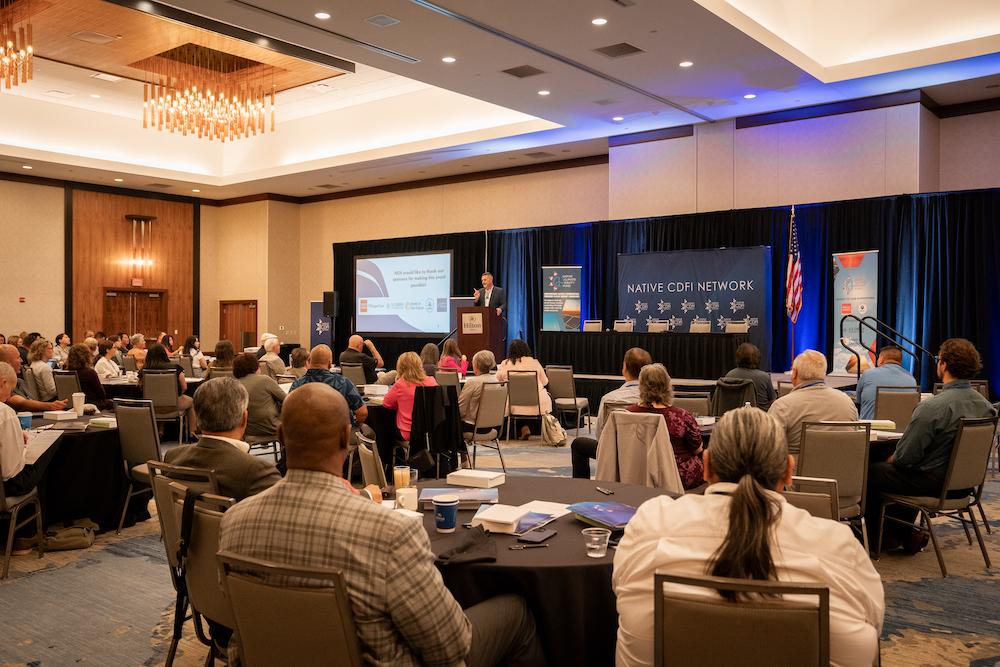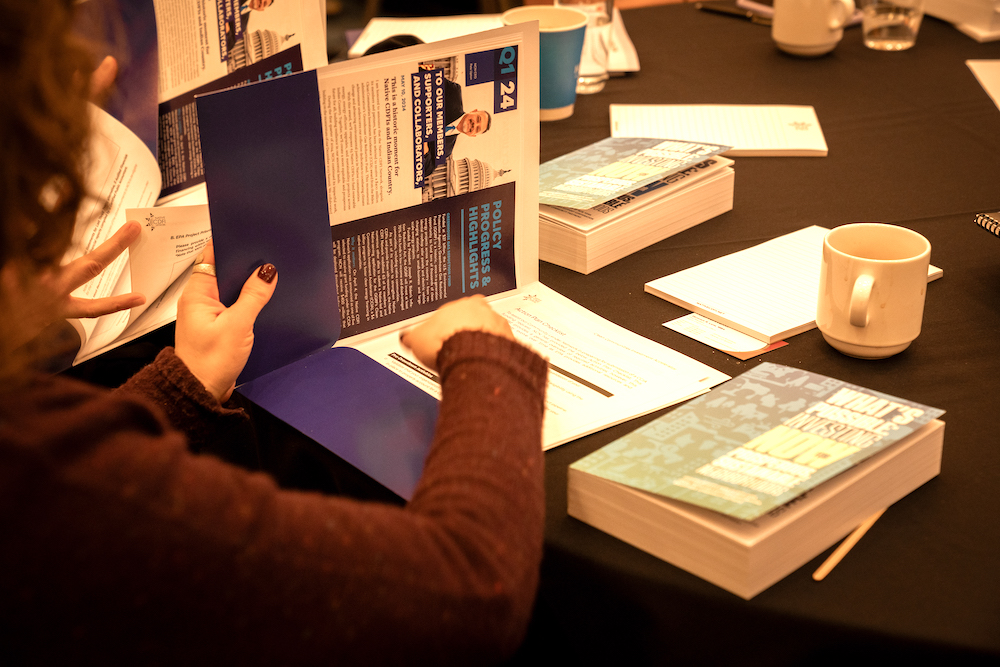
- Details
- By Native StoryLab
- Sponsored Content
When 63 Native CDFIs gathered in Omaha last October, the mood was electric. These community lenders weren't just discussing clean energy projects – they saw EPA's $400 million investment as a chance to transform tribal economic development, workforce development and access to capital in Indian Country.
"This isn't about rushing to deploy capital," explains Kristen Wagner, national program director for the Native CDFI Network Native CDFI Network (NCN). "We're building capacity from the ground up, because that's where lasting change begins."
The context is crucial. Fifty years after the Indian Self-Determination and Education Assistance Act, Native communities continue confronting systemic barriers to economic opportunity. Recent research highlights these challenges: Native reservation lands are 46 percent less likely to host wind farms and over 110 percent less likely to host solar farms compared to adjacent lands with similar potential.
The barriers are profound. Energy project approvals on reservation lands require an average of 49 administrative steps, compared to just four on private lands, according to economic research by the University of Wisconsin-Madison. Regulatory tangles, interagency confusion, and jurisdictional complexities have long stifled tribal economic development.
NCN's $400 million EPA Clean Communities Investment Accelerator award represents more than funding – it's a strategic opportunity to dismantle these obstacles. "You can't truly serve a community until you understand their needs firsthand," says Pete Upton, NCN's CEO. "We're creating the foundation for projects that will reduce dependency on federal funding while creating real economic sovereignty."
The capacity-building effort is comprehensive. NCN has launched a clean energy finance certificate program that combines market research training, community outreach strategies, and specialized lending expertise. Weekly technical assistance calls help lenders navigate everything from solar project assessment to electric vehicle infrastructure financing. Regular regional gatherings connect CDFIs with technical experts, successful tribal energy developers, and potential investment partners.
"We're building expertise layer by layer," Wagner explains. "Our lenders are learning to evaluate projects, structure complex deals, and create the kinds of innovative financing packages that work in Indian Country.”
Lance Morgan, CEO of Ho-Chunk, Inc., has led the Winnebago Tribe's development corporation from startup to $600 million enterprise, doubling the reservation's middle class. He spoke about leveraging federal investments at the Native CDFI Network gathering in Omaha. (Photo: Haven Mattingly/Native CDFI Network)
The Native CDFIs' approach extends far beyond traditional federal funding. They're assembling complex capital stacks that draw from multiple sources: philanthropic investments, banking sector support, tax credit-motivated private investors, and catalytic capital. By diversifying funding streams, they are creating more flexible, sustainable financing models for tribal energy projects. Long-term, low-cost loans complement these approaches, allowing tribes to develop projects with greater financial autonomy and reduced dependency on single funding sources.
The approach exemplifies what Native CDFIs do best — leveraging every hard-fought dollar to maximize impact in their communities. "CDFIs leverage federal funds eight to one," Upton explains. "We're going to be able to leverage this capital tremendously, continue to grow the balance sheets of our Native CDFIs and keep building Native communities."
The approach has already shown results. In Alaska, Native CDFIs are developing expertise in microgrid financing. In the Southwest, lenders are working closely with the Navajo Nation and Hopi Tribe on comprehensive energy planning. Each project starts with extensive community consultation and careful capacity building.
“One of the larger issues we face in housing is the overwhelming cost of disasters,” said Mel Willie, director of Native American partnerships and strategies at NeighborWorks America. “Tribes have become increasingly sophisticated in how they plan, invest in, build and rebuild housing – both new and older units – that will be resilient to natural disasters and create energy savings.”
At the same time, Willie said, “Tribes and Tribal Housing programs need to think about how to be even more resilient in overcoming those issues. We need to have a partnership with the financial services industry to support our investments.” In part, he said, it’s about building relationships with Tribal governments, which are unique and sovereign entities that exist in the United States.
That need for stronger financial partnerships is exactly why institutions like Wells Fargo are stepping up to support Native CDFIs in building long-term economic resilience.
“We are enthusiastic about the work that NCN is doing to lift up opportunities for Native Community Development Financial Institutions (NCDFIs),” said Tim Rios, senior vice president and rural strategy leader at Wells Fargo. “Through Wells Fargo’s Invest Native effort, we are helping NCN scope the tremendous need in California and Nevada. NCDFIs play a critical role in fostering economic self-sufficiency and community resilience by providing culturally relevant financial services to Native communities. They help bridge capital gaps, support local entrepreneurs, and help tribal nations to build sustainable futures.”
Conservative lawmakers have surprisingly embraced the focus on tribal self-sufficiency. As one Native CDFI leader noted during congressional outreach: "This isn't about climate change - it's about getting out of their hair by becoming energy independent."
The potential is significant. Researchers estimate that fully developing renewable energy resources across the poorest reservations could generate revenues approaching $50,000 per tribal member – a transformative sum in communities often marked by economic marginalization.
"When you look at tribal communities still lacking basic electricity access - 10,000 homes on Navajo Nation alone - you understand why this methodical approach matters," Wagner says. "We're not just financing projects. We're building financial sovereignty that will benefit Native communities for generations."
The Native CDFI energy initiative represents more than an infrastructure program. It's a sophisticated expression of self-determination – patient, principled, and powered by community wisdom.
______________________________________

Building Capacity from the Ground Up
NCN is deploying multiple strategies and events to help Native CDFIs develop clean energy financing expertise:
- Weekly technical assistance calls from July-December 2024 for lenders exploring clean energy finance
- New 10-session clean energy finance certificate program launching February 2025, covering market research, community outreach, and lending types
- California partnership event with NeighborWorks and Wells Fargo (Feb 25-27) linking clean energy, housing, and workforce development
- Breakout sessions at RES to connect tribes with CDFIs for energy project finance
- First wave of CCIA lenders to receive technical assistance funding by March 2024
- Regional meetings to share best practices and build networks
- Training on complex capital stacks combining philanthropy, banking, tax credits, and federal funding
Source: Native CDFI Network